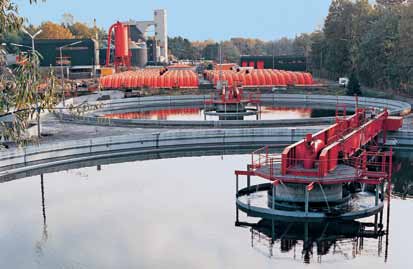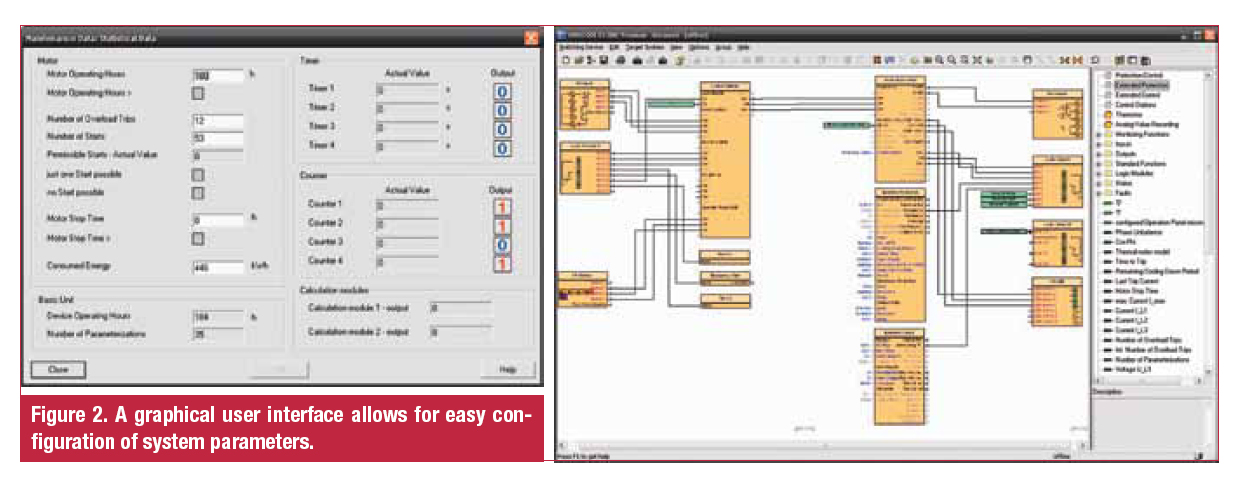Data-driven visibility helps protect industrial processes and motors.
Industrial producers typically invest millions in their infrastructure. Despite such investments, many production facilities lack critical motor performance monitoring and reporting capabilities to help maximize efficiency and energy use and better manage overall operating costs.
Without the kind of data provided by integrated automation, producers are similar to a race car driver in a 200-mile-per-hour race who is just using a common automobile dashboard's fuel, speed and temperature gauges. Limited visibility into the performance of their production processes—and therefore how to optimize them—is only part of the challenge that producers face. If a process breaks down and production stops, costs of lost output and standby labor can mount by the hour.
Motors Are the Muscle
Electric motors are the muscle that keeps materials and work in progress in industrial processes. When a motor fault occurs, production can come to a halt until the cause is diagnosed and repaired and the motor restarted. These outcomes can put production at risk—ranging from reasonable (restart within seconds) to costly (restart taking hours or days).
Risk Insurance
Overload relays were invented to protect industrial motors from damages caused by overload conditions. They are specialized devices that can sense an overload or other adverse circuit condition, open a circuit and then provide control or some operational indicator. In effect, the motor protective function of a conventional overload relay can place process productivity at risk by protecting its connected motor.
Different overload relay types are available, ranging from simple thermal sensing units to more complex, solid-state relays. These may include a wide range of programmed intelligence and reporting capabilities, which is called smart motor management (SMM). An important feature of this type of SMM device is the capability of assuming local control of the process if communication is lost. While overload relays are designed to protect the motor only, SMM can help protect the motor and the process it drives.
Weak Link in Complex Processes
In the past few decades, industrial processes have become increasingly complex. Fast-changing market demands, including customer expectations of more diverse products (and mass customization of those products), require tremendous production flexibility from manufacturers. Competition among manufacturers drive them to respond.
Given this complexity and the demands for manufacturing flexibility and responsiveness, industrial engineers face the challenge to keep up. No matter how sophisticated their process and control designs, simple or catastrophic motor failure anywhere along the line can stop feeder, production or collateral processes with many possible consequences.
Smart Motor Management
Traditional motor starters, controlled by a PLC or DCS, provide little status and diagnostic data into the connected control system. For years, a single, contactor-operated auxiliary contact (ON status) and an overload-relay-operated auxiliary contact (FAULT status) wired to PLC or DCS inputs provided acceptable levels of status and diagnostic data.
A cost is associated with each input status and output control in a conventional PLC or DCS control system. In addition, a cost and complexity to wire is associated with the conventional two inputs and one output of the traditional motor starters.
In fact, the total cost of wiring 25 motor starters to their PLC or DCS alone (figuring an average of 100 feet of wire for each connection) can be up to $15,000, not counting conduit, cable tray or I/O cabinet space. Nor does it account for the difficulty in troubleshooting about 2.5 miles of wire if something goes wrong.
Clearly, another approach is needed. smart motor management. With an SMM device in place, all this information can be brought into the PLC or DCS without additional traditional I/O or interconnecting wiring, saving thousands.
Simply defined, this SMM model uses the latest in compact, solid-state technology configured with modular, pre-configured intelligence to provide a wide range of real-time operational data that can be used for early warning and post-fault diagnostics.
The configurable nature of SMM devices allows the user to select the device response to conditions that would cause other motor overload relays to trip.

Figure 1. Optional measurements are also available with SMM.
Network or Local Control
If network communications fail, the intelligent overload relay can immediately take over local control of the motor until the network comes back up, keeping the process motors moving. When network operation returns, the local operating data updates the central control unit, so its operating profile stays current. In addition to predefined motor control applications, user defined logic elements, such as truth tables, timers, counters, etc. are included to allow the user to customize the predefined motor control applications to meet their individual needs.
Using PROFIBUS communications, these intelligent overload relays can provide much more operational data and information, such as:
- Load status (on, off, warning, trip)
- Warning and trip indicators (jam, loss of load, vibration and more)
- Statistical data (starts, trips, operating hours)
- Measured values (current, voltage, power factor, KW, temperature and more)
PROFIBUS DP can also save the cost and hassle of conventional wiring: up to 124 devices can be connected to a single two-wire network connection. These savings can add up fast and help offset, if not pay for, a plant's conversion to SMM. At the very least, the savings can accelerate the plant's ability to break even on its investment.
Power measurements such as the ones listed in Figure 1 can help plant management monitor site power consumption much more precisely and shed loads down to a single motor, which can help reduce peak usage charges. This information can also help them compare measured energy usage with utility billings to check for possible over-charges and get reimbursed. In effect, all the additional data that can be used to open a “window of visibility” for optimizing a plant's motor infrastructure becomes available.
Applications
SMM, has many uses in industrial processes, whether the processes feed production, make up production or dispose of production wastes.
Pumps & Mixers
Fluids can be part of industrial production as work-in-progress gets washed, cooled, coated, rinsed or any combination, with excess fluids re-circulated or disposed. In some cases, fluids themselves are the work-in-progress, whether producing harsh chemicals or baby formula.
Of course, mixers are used to combine inputs while pumps keep the material moving unless a motor faults or perhaps a pump rotor bearing fails. Either way, production can stop, or if upstream flows do not stop, pressure buildup can damage piping, seals or create unsafe conditions.
If a rotary bearing fails due to increased friction, two conditions occur: motor current or variant temperature. SMM devices can measure the increased motor current. Add a temperature input, and they can monitor the temperature increase. In this situation, the SMM device senses the condition(s) and alerts plant management so that a technician can be dispatched to fix the problem before the process fails.
Cooling Towers
Many plants require cooling towers with industrial fans to release the heat generated by production. Exhaust fans are also used to draw off fumes that a petrochemical plant may produce or the dust that a milling operation can generate.
When fans get out of balance, their vibrations can begin to degrade their motors' performance. With an analog sensor connected to the SMM device, vibrations outside set parameters can signal that a fan needs maintenance before the motor faults, which can prevent a fan failure that would force a production shutdown and possibly invoke OSHA, EPA and other regulatory fines.
Valves
Industrial plants can have many hundreds, if not thousands, of PLC-controlled, motor-driven valves that open and close at specific production points. Timing of the valve's operation often requires exacting precision to allow just the right amount of fluid ingredients into the process or effluent waste out.
When a valve gets stuck, a process can be slowed or possibly even flawed as incorrect amounts of inputs enter the production flow or waste isn't appropriately discharged. SMM devices can signal the problem because the valve's motor current will increase. Plant management can immediately send a technician to fix the valve prior to failure.
Circuit Breakers
For non-communicating breakers, SMM can measure the current, voltage and power usage at the breaker level and transfer those measurements back to the PLC and DCS. This is a cost effective solution for intermediate energy consumption measurement.

Early knowledge of valve motor current problems can help avoid failure.
Configuration, Not Programming
Advanced intelligent overload relays have sophisticated yet easy-to-use configuration software that eliminates costly and time-consuming programming. A graphical user interface (see Figure 2) enables users to select applications easily. No programming or complicated configuring is needed. For example, configuring the SMM device illustrated in Figure 2 to sense and report over-current conditions requires just two mouse-clicks.
Samples of one SMM's pre-programmed functional applications include:
Protective Functions
- Overload protection (Class 5 - 40)
- Thermistor motor protection
- Phase failure monitoring
- Unbalance protection
- Stall protection
- Earth-fault monitoring
- Monitoring of current limit values
- Monitoring of operating hours
- Monitoring of motor stop times
- Number-of-starts monitoring
Control Functions
- Direct online starter
- Reversing starter
- Star-delta starter
- Star-delta starter with reversal of rotational direction
- Two speeds, motors with separate windings (pole changeover switch), also with reversal of rotational direction
- Two speeds, motors with separate Dahlander windings, also with reversal of rotational direction
- Solenoid valve actuation
- Positioner actuation
- Soft starter actuation
- Soft starter actuation with reversal of rotational direction
Expanded Monitoring Functions
- Temperature monitoring Pt100, Pt1000, KTY83, KTY84
- Voltage monitoring
- Power monitoring
- Cos-phi monitoring
- Phase sequence detection
- Input, output and monitoring 0/4-20 mA signal
- Measuring curves reporting
Additionally
- Logic modules (truth tables, counters, timers, edge evaluation, limit monitoring and more)
- Standard functions (power failure monitoring, emergency start, external faults and more)
Clyde Bergemann Case Study
Atlanta-based Clyde Bergemann Inc., an OEM supplier of state-of-the-art boiler cleaning systems, wanted to offer customers efficient and future-proof solutions for the modernization of its boiler systems. Its process engineers chose an SMM for its distributed design. They found its features provided many more useful functions which help make the engineers' work much easier and reduce costs.
As a flexible and modular system, it can be easily connected to PROFIBUS, offers a standardized interface and provides detailed operational, service and diagnostics data. It can be easily parameterized and guarantees a reliable cleaning operation even under harsh ambient conditions.
Paulaner Brewery Case Study
Operating for 24 hours per day every day of the year, Munich's Paulaner brewery produces approximately 66 million gallons of beer per year. To maintain this output and make the plant fit for the future, management decided to deploy a modular and expandable SMM platform when modernizing the filtration system control technology. Especially appealing was the high functionality of SMM device that went far beyond just measuring current.
Thanks to the increased number of signal connections realized with the addition of digital modules, all filtration and cooling process steps can be centrally monitored and controlled. Process data are directly transferred to the control center. The high plant transparency assures a precise detection and fast correction of motor faults as well as the easy configuration of standardized diagnostic routines.

Figure 2. A graphical user interface allows for easy configuration of system parameters.
Conclusion
Efficient and cost-effective industrial process and control designs are more critical than ever to the vitality, profitability and future of manufacturing and processing industries. That is because market demands and competitor pressures require flexibility, adaptability and responsiveness, while optimal performance helps ensure cost-competitiveness. To gain these benefits, plant management should investigate SMM and its applications. This can deliver the motor data needed for greater operational visibility, energy savings and motor life. It can also effectively enable processes to become “situation-aware” to help prevent shutdown due to a motor failure. This alone can more than pay for the capital costs and help lower the life cycle costs.
Pumps & Systems, October 2011


